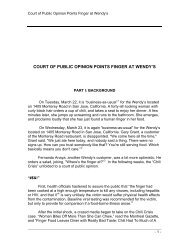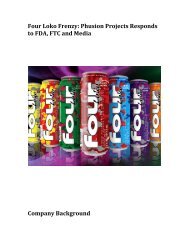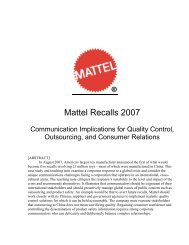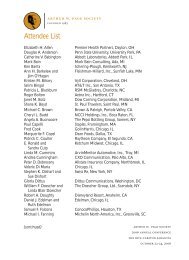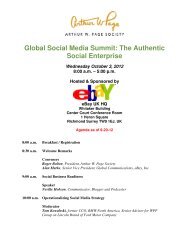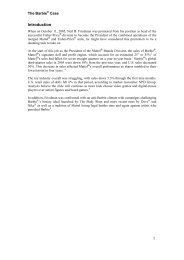The Barbie Case - The Arthur Page Society
The Barbie Case - The Arthur Page Society
The Barbie Case - The Arthur Page Society
Create successful ePaper yourself
Turn your PDF publications into a flip-book with our unique Google optimized e-Paper software.
and “Linde.” <strong>The</strong>se regional companies monitor Russian<br />
dealers stringently. <strong>The</strong>refore, under these arrangements,<br />
Russian sellers’ profit margins have fallen. <strong>The</strong> local<br />
representatives of the parent companies are very active in<br />
offering their product directly to customers. However, they<br />
consider only those customers who buy the whole “package”<br />
of equipment for the huge store or supermarket. In return<br />
the customers get hefty discounts and special offers.<br />
Currently, European representatives possess a relatively small<br />
proportion of the market. However, they are very active and<br />
are trying to capture the larger, more lucrative customers.<br />
Pallet Trucks<br />
Creation of the Business Structure<br />
<strong>The</strong> business structure of Pallet Trucks aided it in handling<br />
the crisis that unfolded in 2001. In 2001, Pallet Trucks had an<br />
exclusive sales relationship with Pfaff-silberblau to sell its<br />
lifting and handling equipment in Russia. At the time, the<br />
business structure of Pallet was created to:<br />
1. Bring the product closer to customers. New branches of<br />
Pallet Trucks were set up in cities and towns where many<br />
new retail outlets were being opened.<br />
2. Increase sales volume by setting up this extensive network.<br />
Increasing volume would give the company the<br />
opportunity to lower prices. In effect, this led the company<br />
to capture 27% of the market share.<br />
Crisis<br />
In September 2001, the young Russian company Pallet Trucks<br />
(formed in 1996) discovered that the market was flooded<br />
with fake copies of the lifting and handling equipment of its<br />
German partner Pfaff-silberblau.Uncertified factories in China<br />
were producing these machines and small Russian firms were<br />
selling them at 30% lower prices to Russian customers.<br />
Pallet Trucks, as a result of its environment scanning, realized<br />
the Pfaff brand was being pirated after certain firms<br />
advertised sales of Pfaff-silberblau’s equipment. Pallet Trucks<br />
was, at the time, the exclusive representative of Pfaffsilberblau<br />
equipment. It knew very well that the advertised<br />
equipment was either acquired through dubious means or<br />
had to be fake. To determine which was the case,<br />
representatives of Pallet Trucks bought samples of the<br />
counterfeit equipment to determine its quality. <strong>The</strong> findings<br />
of the experts were clear: the equipment was fake. <strong>The</strong><br />
reduced quality of the fake equipment was described in the<br />
official documents and the information was used at the press<br />
conference announcing the problem.<br />
arthur w. page society<br />
Although it is considered unusual to see counterfeit lifting<br />
and handling equipment on the market, in practice it turned<br />
out that production was not difficult to organize in China.<br />
<strong>The</strong> Pallet Trucks and Pfaff-silberblau CEOs made the decision<br />
to use public relations strategies instead of filing lawsuits<br />
against several Russian firms selling the fake equipment. In<br />
Russia, the situation is that the official law can take a long<br />
time to resolve cases and appeals. Even having proof that<br />
competitors were selling counterfeit equipment might not be<br />
enough to win the case. Legal cases can be drawn out, are<br />
expensive, and the outcome not assured.<br />
<strong>The</strong> Business Problem<br />
<strong>The</strong> immediate problem facing the two partners was profit<br />
loss. But an even bigger challenge was the blot on their<br />
reputations. A company’s brand image affords it market<br />
credibility and quality assurance. Negative word-of-mouth<br />
about equipment quality was causing serious harm to sales.<br />
Users of the products were telling potential customers about<br />
the product’s failure.<br />
Although we cannot illustrate how the crisis financially<br />
affected the company, as the Russian stock market is not yet<br />
formed and profit information is officially confidential, this<br />
case study is based on the analysis of Russian and German Web<br />
sites, trade magazines, an interview with Galina Shchepilova,<br />
the public relations director of Pallet Trucks, Moscow, and<br />
copies of the corporate newsletter of Pallet Trucks.<br />
<strong>The</strong> Main Elements of the PR<br />
Campaign: <strong>The</strong> Response<br />
During the public relations campaign, the main decisions<br />
were: 1) to respond quickly to the situation at hand; 2) to<br />
change the attitude of the market participants; 3) to<br />
successfully segment editors and journalists (trade magazines,<br />
information agencies, business editions); 4) to invite<br />
Heinrich Pfaff and Otto Muller to Moscow and organize a<br />
press conference; 5) to continue to develop a brand image of<br />
Pallet Trucks after solving the problem.<br />
45



